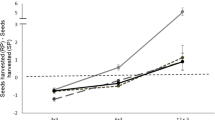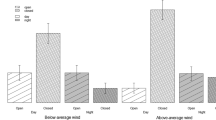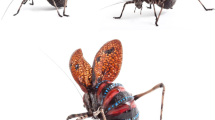Abstract
In a foraging game, predators must catch elusive prey while avoiding injury. Predators manage their hunting success with behavioral tools such as habitat selection, time allocation, and perhaps daring—the willingness to risk injury to increase hunting success. A predator’s level of daring should be state dependent: the hungrier it is, the more it should be willing to risk injury to better capture prey. We ask, in a foraging game, will a hungry predator be more willing to risk injury while hunting? We performed an experiment in an outdoor vivarium in which barn owls (Tyto alba) were allowed to hunt Allenby’s gerbils (Gerbillus andersoni allenbyi) from a choice of safe and risky patches. Owls were either well fed or hungry, representing the high and low state, respectively. We quantified the owls’ patch use behavior. We predicted that hungry owls would be more daring and allocate more time to the risky patches. Owls preferred to hunt in the safe patches. This indicates that owls manage risk of injury by avoiding the risky patches. Hungry owls doubled their attacks on gerbils, but directed the added effort mostly toward the safe patch and the safer, open areas in the risky patch. Thus, owls dared by performing a risky action—the attack maneuver—more times, but only in the safest places—the open areas. We conclude that daring can be used to manage risk of injury and owls implement it strategically, in ways we did not foresee, to minimize risk of injury while maximizing hunting success.





Similar content being viewed by others
References
Ackermann J, Redig P (1997) Surgical repair of elbow luxation in raptors. J Avian Med Surg 11:247–254
Adamec RE, Starkadamec C, Livingston KE (1980) The development of predatory aggression and defense in the domestic cat (felis-catus).III. Effects on development of hunger between 180 and 365 days of age. Behav Neural Biol 30:435–447. doi:10.1016/S0163-1047(80)91274-1
Altwegg R (2003) Hungry predators render predator-avoidance behavior in tadpoles ineffective. Oikos 100:311–316. doi:10.1034/j.1600-0706.2003.12206.x
Basuony M, Saleh M, Riad A, Fathy W (2005) Food composition and feeding ecology of the red fox Vulpes vulpes (Linnaeus, 1758) in Egypt. Egypt J Biol 7:96–102
Berger-Tal O, Kotler BP (2010) State of emergency: behavior of gerbils is affected by the hunger state of their predators. Ecology 91:593–600. doi:10.1890/09-0112.1
Berger-Tal O, Mukherjee S, Kotler BP, Brown JS (2009) Look before you leap: is risk of injury a foraging cost? Behav Ecol Sociobiol 63:1821–1827. doi:10.1007/s00265-009-0809-3
Berger-Tal O, Mukherjee S, Kotler BP, Brown JS (2010) Complex state-dependent games between owls and gerbils. Ecol Lett 13:302–310. doi:10.1111/j.1461-0248.2010.01447.x
Bradley JE, Marzluff JM (2003) Rodents as nest predators: influences on predatory behavior and consequences to nesting birds. AUK 120:1180–1187. doi:10.1642/0004-8038(2003)120[1180:RANPIO]2.0.CO;2
Brown JS (1988) Patch use as an indicator of habitat preference, predation risk, and competition. Behav Ecol Sociobiol 22:37–47. doi:10.1007/BF00395696
Brown JS (1999) Vigilance, patch use and habitat selection: foraging under predation risk. Evolut Ecol Res 1:49–71
Brown JS, Kotler BP (2004) Hazardous duty pay and the foraging cost of predation. Ecol Lett 7:999–1014. doi:10.1111/j.1461-0248.2004.00661.x
Brown JS, Laundre JW, Gurung M (1999) The ecology of fear: optimal foraging, game theory, and trophic interactions. J Mamm 80:385–399. doi:10.2307/1383287
Brown JS, Kotler BP, Bouskila A (2001) Ecology of fear: foraging games between predators and prey with pulsed resources. Ann Zool Fennici 38:71–87
Charnov EL, Orians GH, Hyatt K (1976) Ecological implications of resource depression. Am Nat 110:247–259. doi:10.1086/283062
Csermely D, Berte L, Camoni R (1998) Prey killing by Eurasian Kestrels: the role of the foot and the significance of bill and talons. J Avian Biol 29:10–16. doi:10.2307/3677335
Dall SRX, Kotler BP, Bouskila A (2001) Attention, apprehension, and gerbils searching in patches. Ann Zool Fennica 38:15–23
Damsgard B, Dill LM (1998) Risk-taking behavior in weight-compensating coho salmon, Oncorhynchus kisutch. Behav Ecol 9:26–32
Embar K, Kotler BP, Mukherjee S (2011) Risk management in optimal foragers: the effect of sightlines and predator type on patch use, time allocation, and vigilance in gerbils. Oikos 120:1657–1666. doi:10.1111/j.1600-0706.2011.19278.x
Embar K, Raveh A, Hoffman I, Kotler BP (2014) Predator facilitation or interference: a game of vipers and owls. Oecologia 174:1301–1309. doi:10.1007/s00442-013-2760-2
Godin JGJ, Crossman SL (1994) Hunger-dependent predator inspection and foraging behaviors in the threespine stickleback (gasterosteus-aculeatus) under predation risk. Behav Ecol Sociobiol 34:359–366. doi:10.1007/BF00197006
Grant Gilchrist H, Gaston JA, Smith JNM (1998) Wind and prey nest sites as foraging constraints on an avian predator, the Glaucous Gull. Ecology 79:2403–2414. doi:10.1890/0012-9658(1998)079[2403:WAPNSA]2.0.CO;2
Hayward MW, Henschel P, O’Brien J, Hofmeyr M, Balme G, Kerley GIH (2006a) Prey preferences of the leopard (Panthera pardus). J Zool 270:298–313. doi:10.1111/j.1469-7998.2006.00139.x
Hayward MW, Hofmeyr M, O’Brien J, Kerley GIH (2006b) Prey preferences of the cheetah (Acinonyx jubatus) (Felidae: carnivora): morphological limitations or the need to capture rapidly consumable prey before kleptoparasites arrive? J Zool 270:615–627. doi:10.1111/j.1469-7998.2006.00184.x
Holt DW, Layne EA (2008) Eye injuries in long-eared owls (Asio otus): prevalence and survival. J Raptor Res 42:243–247. doi:10.3356/JRR-07-42.1
Juliana JRS, Kotler BP, Brown JS, Mukherjee S, Bouskila A (2011) The foraging response of gerbils to a gradient of owl numbers. Evol Ecol Res 13:869–878
Kauffman MJ, Varley N, Smith DW, Stahler DR, MacNulty DR, Boyce MS (2007) Landscape heterogeneity shapes predation in a newly restored predator-prey system. Ecol Lett 10:690–700. doi:10.1111/j.1461-0248.2007.01059.x
Kotler BP (1992) Behavioral resource depression and decaying perceived risk of predation in two species of coexisting gerbils. Behav Ecol Sociobiol 30:239–244. doi:10.1007/BF00166708
Kotler BP, Brown JS (1990) Rates of seed harvest by two species of gerbiline rodents. J Mamm 71:591–596. doi:10.2307/1381798
Kotler BP, Brown JS, Hasson O (1991) Factors affecting gerbil foraging behavior and rates of owl predation. Ecology 72:2249–2260. doi:10.2307/1941575
Kotler BP, Brown JS, Dall SRX, Gresser S, Ganey D, Bouskila A (2002) Foraging games between gerbils and their predators: temporal dynamics of resource depletion and apprehension in gerbils. Evol Ecol Res 4:495–518
Kotler BP, Brown JS, Bouskila A (2004) Apprehension and time allocation in gerbils: the effects of predatory risk and energetic state. Ecology 85:917–922. doi:10.1890/03-3002
Kotler BP, Brown JS, Mukherjee S, Berger-Tal O, Bouskila A (2010) Moonlight avoidance in gerbils reveals a sophisticated interplay among time allocation, vigilance and state-dependent foraging. Proc R Soc Lond [Biol] 277:1469–1474. doi:10.1098/rspb.2009.2036
Kullberg C (1995) Strategy of the pygmy owl while hunting avian and mammalian prey. Ornis Fennica 72:72–78
Laroche RK, Kock AA, Dill LM, Oosthuize WH (2008) Running the gauntlet: a predator-prey game between sharks and two age classes of seals. Anim Behav 76:1901–1917
Mao JS, Boyce MS, Smith DW, Singer FJ, Vales DJ, Vore JM, Merrill EH (2005) Habitat selection by elk before and after wolf reintroduction in Yellowstone National Park. J Wildl Manag 69:1691–1707. doi:10.1002/jwmg.422
McCarty R, Southwick CH (1981) Food deprivation: effects on the predatory behavior of Southern Grasshopper Mice Onychomys torridus. Aggress Behav 7:123–130
Mech LD, McIntyre RT, Smith DW (2004) Unusual behavior by Bison, Bison bison, toward Elk, Cervus elaphus, and Wolves, Canis lupus. Can Field-nat 118:115–118
Morris DW (1987) Ecological scale and habitat use. Ecology 68:362–369. doi:10.2307/1939267
Mukherjee S, Heithaus MR (2013) Dangerous prey and daring predators: a review. Biol Rev 88:550–563. doi:10.1111/brv.12014
Perlman Y, Tsurim I (2008) Daring, risk assessment and body condition interactions in steppe buzzards Buteo buteo vulpinus. J Avian Biol 39:226–228. doi:10.1111/j.2008.0908-8857.04251.x
Polsky RH (1975) Hunger, prey feeding and predatory aggression. Behav Biol 13:81–93. doi:10.1016/S0091-6773(75)90823-8
Quinn JL, Cresswell W (2004) Predator hunting behaviour and prey vulnerability. J Anim Ecol 73:143–154. doi:10.1046/j.0021-8790.2004.00787.x
Raveh A, Kotler BP, Abramsky Z, Krasnov BR (2011) Driven to distraction: detecting the hidden costs of flea parasitism through foraging behaviour in gerbils. Ecol Lett 14:47–51. doi:10.1111/j.1461-0248.2010.01549.x
Roth TC, Lima SL (2007) Use of prey hotspots by an avian predator: purposeful unpredictability? Am Nat 169:264–273. doi:10.1086/510605
Sih A (1992) Prey uncertainty and the balancing of antipredator and feeding needs. Am Nat 139:1052–1069. doi:10.1086/285372
Sih A, Englund G, Wooster D (1998) Emergent impacts of multiple predators on prey. Trends Ecol Evolut 9:350–355. doi:10.1016/S0169-5347(98)01437-2
Sunde P (2002) Starvation mortality and body condition of Goshawks Accipiter gentilis along a latitudinal gradient in Norway. IBIS 144:301–310. doi:10.1046/j.1474-919X.2002.00050.x
Sunde P (2005) Predators control post-fledging mortality in tawny owls, Strix aluco. Oikos 110:461–472. doi:10.1111/j.0030-1299.2005.14069.x
Thouzeau C, Duchamp C, Handrich Y (1999) Energy metabolism and body temperature of barn owls fasting in the cold. Physiol Biochem Zool 72:170–178. doi:10.1086/316659
Vijayan S, Kotler BP, Mukherjee S, Brown JS, Bouskila A (2007) Influence of cover on foraging behavior of Negev desert gerbils. Basic Appl Dryland Res 1:51–66 (Arbeitskreises Wüstenökologie (Germany))
Walker SE, Rypstra AL (2003) Hungry spiders aren’t afraid of the big bad wolf spider. J Arachnol 31:425–427. doi:10.1636/S02-63
Wignall AE, Taylor PW (2009) Alternative predatory tactics of an araneophagic assassin bug (Stenolemus bituberus). Acta ethologica 12:23–27. doi:10.1007/s10211-008-0049-y
Acknowledgments
We thank the United States-Israel Binational Science Foundation (grant no. 2008163 to Burt P. Kotler and Joel S. Brown) for generous support of this research. We thank two anonymous referees for providing useful comments that improved the manuscript. This is publication no. 833 of the Mitrani Department of Desert Ecology.
Author information
Authors and Affiliations
Corresponding author
Additional information
Communicated by Peter Banks.
Electronic supplementary material
Below is the link to the electronic supplementary material.
Rights and permissions
About this article
Cite this article
Embar, K., Raveh, A., Burns, D. et al. To dare or not to dare? Risk management by owls in a predator–prey foraging game. Oecologia 175, 825–834 (2014). https://doi.org/10.1007/s00442-014-2956-0
Received:
Accepted:
Published:
Issue Date:
DOI: https://doi.org/10.1007/s00442-014-2956-0




